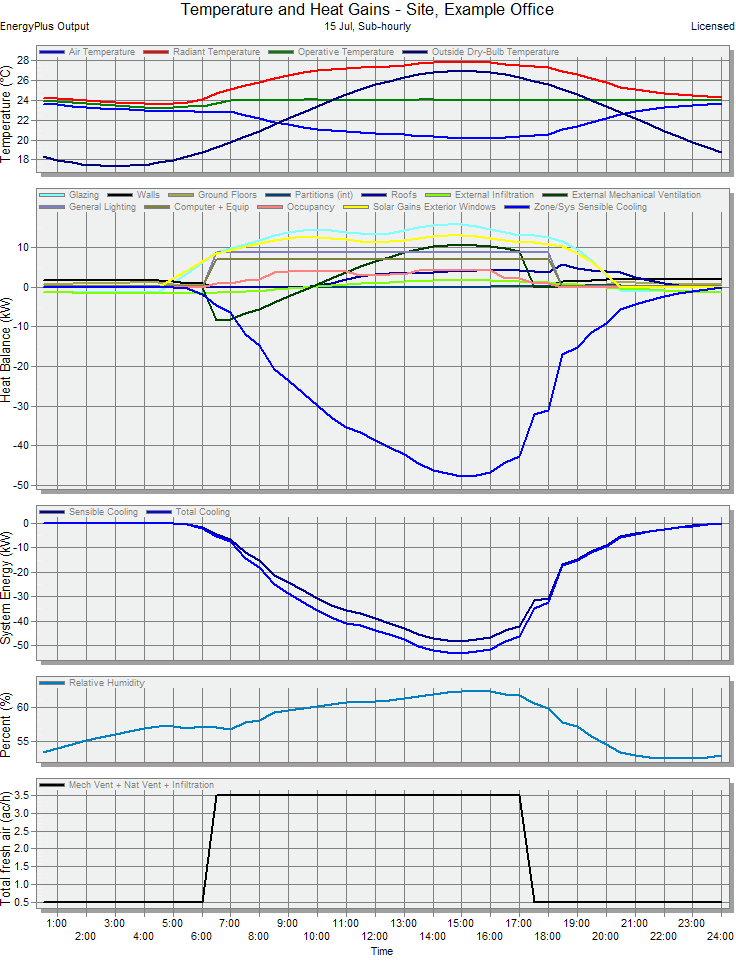Open topic with navigation
Cooling Design Detailed Results
The 'Analysis' tab has detailed half-hourly cooling
design results (displayed as a line graph by default).
For more on how the output is calculated see: Calculation
of DesignBuilder Output from EnergyPlus Report Variables.
- Air Temperature
- the calculated average temperature of the air.
- Radiant Temperature
- the (area * emissivity) weighted average of the zone inside surface temperatures.
- Operative Temperature
- The mean of the mean internal air and mean radiant temperatures.
- Outside Dry-Bulb Temperature.
- Glazing - the total
heat flow to the zone from the glazing, frame and divider of exterior
glazing excluding transmitted short-wave solar radiation (which is accounted
for in Solar Gains Exterior Windows below).
For windows without
an interior shading device this heat flow is equal to:
+ [Convective heat flow to the zone from
the zone side of the glazing]
+ [Net IR heat flow to the zone from zone
side of the glazing]
– [Short-wave radiation from zone transmitted
back out the window]
+ [Conduction to zone from window frame and
divider, if present]
Here, short-wave radiation is that from lights
and diffuse interior solar radiation.
For windows with
an interior shading device this heat flow is equal to:
[Convective
heat flow to the zone from the air flowing through the gap between glazing
and shading device]
+ [Convective heat flow to the zone from
the zone side of the shading device]
+ [Net IR heat flow to the zone from the
zone side of the glazing]
+ [Net IR heat flow to the zone from the
zone side of the shading device]
– [Short-wave radiation from zone transmitted
back out the window]
+ [Conduction to zone from window frame and
divider, if present]
- Walls - heat gain
due to conduction through all external walls, including the effect of
solar radiation and longwave radiation to the sky.
- Roofs - heat gain
due to conduction through all external roofs, including the effect of
solar radiation and longwave radiation to the sky.
- Ceilings (int) -
heat conduction gain through internal ceilings (e.g. zone above is colder).
- Floors (int) - heat
conduction gain through internal floors (e.g. zone below is colder).
- Floors (ext) - heat
conduction gain through external floors (not ground floor, e.g. floor
in cantilevered space, roof eaves etc).
- Ground floors -
heat conduction gain through ground floors.
- Partitions (int)
- heat conduction gain due to heat conduction through all internal partitions
from adjacent zones at different temperatures.
- Doors and vents
- conduction heat gain through doors and vents.
Airflow
- Mech Vent + Nat Vent +
Infiltration - The sum of outside
air (in ac/h) flowing into the zone through:
- The HVAC air distribution system +
- Infiltration +
- Natural ventilation
System Heat Flows (Compact HVAC only)
These heat flows are plotted on the System Energy axes:
- Zone Heating - energy
supplied by local room heaters and reheat coils to maintain room internal
heating temperature setpoint temperature when using Compact HVAC data.
- Total Cooling - depending
on the Sizing method:
- for the default ASHRAE
sizing method Total Cooling is the rate at which total energy (sensible
and latent) is removed from the mixed outside and return air stream in
order to bring the mixed air stream to the specified
temperature and humidity ratio of the supply air stream.
- for Compact
HVAC sizing method - at building
level: sensible + latent cooling transfer to the supply air from
the AHU cooling coil + any single zone unitary and fan coil units in the
building. At zone level: sensible
+ latent cooling transfer to the supply air from a single zone unitary
or fan coil unit.
- Sensible Cooling -
depending on the Sizing method:
- for ASHRAE
sizing method Sensible Cooling is the rate at which sensible energy is removed
from the mixed outside and return air stream in order to lower its temperature
to the specified temperature of
the supply air stream. Any energy needed for moisture addition or removal
is ignored.
- for Compact
HVAC sizing method Sensible Cooling is sensible only cooling heat transfer from the cooling coil to the supply
air. Latent coil heat can be calculated as the difference: Total
Cooling - Sensible Cooling.
Surface heat gain data refers to heat transfer from the inside surface
of the building elements to the zone.
You can also customise the data and the way it is displayed using the
Display Options panel.


